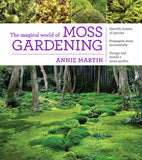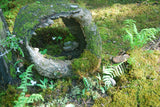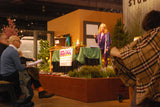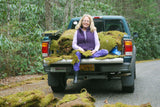Moss Gardening Tips
The Joy of Moss Gardening
Enjoy this free information and please purchase Mossin' Annie's book, The Magical World of Moss Gardening, for in-depth tips and information. Phone consultation services available to discuss your landscape, recommend appropriate species and answer your specific questions.

Mosses always bring a smile to your face whether you are the beholder or the gardener. Since bryophytes have been around for millions of years, it seems like there would be plenty of moss gardening references. Yet, mosses have been overlooked as horticultural choices and little definitive research exists on gardening with bryophytes. Moving beyond generalizations to specific guidelines has been a priority of our research and field testing. Mountain Moss is breaking new ground with innovative ways of using mosses in today's world of new “green” approaches to living.
As public interest in moss gardening continues to increase, it is just a matter of time until horticultural programs at universities start to examine bryophyte applications or academic bryology research focuses on specific bryophyte benefits and growth patterns. As we accumulate and share knowledge about moss gardening, there are implications for further research and documentation of methods. This section begins to address how you can achieve success. There is so much to say that these guidelines barely touch the subject so I’ve written a book to share my expertise. The Magical World of Moss Gardening is available from this site now. We welcome your comments and hope you will follow our Mountain Moss blog for future postings and join in discussions on Qutee.
Landscaping Options
There are various levels of moss awareness and ways people embrace mosses as a landscape option. The most basic approach seems to stop fighting mosses by permitting them to grow in shady areas or disturbed soils where nothing else will grow. This method allows native species to introduce themselves through the process of natural selection. If you live in the right place where indigenous bryophytes are prevalent, this passive philosophy might work. Yet, you can initiate moss in your landscape in stages or attain instant gratification with a solid planting from the beginning.
Approaching mosses with the perspective of a gardener, this higher level of moss thinking uses more systematic methods for achieving the horticultural guideline, Right Place, Right Moss. When landscapers and home gardeners introduce “just any ol’ moss” on their own, it can result in haphazard results. Mimicking the native environment and planting mosses in similar micro-climates is a common way to begin. Choosing a shade location may be to your advantage as a novice. Given the range of bryophyte habitats in natural settings, there is an appropriate moss for just about every place. Choosing the right moss for the right place in your gardenscape will be key to your long-range success.
pH Modification

Moving on up the ladder of planting methods, you can encourage mosses to move in on their own by adjusting pH level of your soil; periodically removing leaf litter from moss colonies; and weeding. This is a more proactive approach than passively hoping.
Although a pH of 5.5 is popularly recommended, please realize that this advice is for acid-loving mosses, not ALL mosses. Stop using lime and any fertilizers. After testing your soil (free through your state's Cooperative Extension Service), apply sulfur or aluminum sulfate to increase acidity. Refer to this chart at Clemson University for the formula.
Leaf Removal

Remove leaves and debris to allow mosses to receive sun required for photosynthesis. Although Autumn is considered leaf season, please realize that debris can fall any time during the year from spring blossoms to male catkins to the never-ending pine needles that fall year-round. Leaf blowers work the best, particularly when leaves are wet. Unless you have a delicate touch, don't rake. Sometimes sweeping with a broom is sufficient. If you are obsessive, a whisk broom or toothbrush can be added to your tools.
Weeding
 Systematic weeding will deter growth of other plants that germinate in mosses. Depending upon moisture and sun exposure, weeding can be minimal in the shade to extensive in sun locations. Remember, mosses are natural nurseries and seeds will germinate in colonies despite elaborate methods to prevent them. Although laborious, hand-weeding is recommended and it gives you a chance to connect up close with your mosses. In Japan, this task is considered a privilege. In shady spots, one thousand square feet might require only 2-3 hours per season whereas a sunny area with colonies of tiny bryophyte mounds might require 1-2 hours every other week. If you feel the need to resort to more drastic measures, a diluted version of weed killer can be applied without harming these non-vascular plants. Try a sample section first.
Systematic weeding will deter growth of other plants that germinate in mosses. Depending upon moisture and sun exposure, weeding can be minimal in the shade to extensive in sun locations. Remember, mosses are natural nurseries and seeds will germinate in colonies despite elaborate methods to prevent them. Although laborious, hand-weeding is recommended and it gives you a chance to connect up close with your mosses. In Japan, this task is considered a privilege. In shady spots, one thousand square feet might require only 2-3 hours per season whereas a sunny area with colonies of tiny bryophyte mounds might require 1-2 hours every other week. If you feel the need to resort to more drastic measures, a diluted version of weed killer can be applied without harming these non-vascular plants. Try a sample section first.
Watering


As seasons change, mosses will remain a constant expanse of green... at least from a distance... and even in the winter. If you take the time to observe mosses in their transitional stages, which occur throughout all months and vary by bryophyte colony, you will be delighted with brilliant colors of sporophytes – a good sign that your mosses are happy campers. The subtle changes of green can range from bright chartreuse to deep juniper. Upon occasion, the leaves of some mosses turn intense yellow (Hypnum and Thuidium). This golden color transition is not indicative of a final life cycle such as in the case of fall leaf color on trees.
With all these glowing endorsements, be prepared that some mosses go through "ugly" transitions or periods of adjustment. If you practice patience and nurture these transitioning colonies, they will astound you once again with their "green."
Note: Some bryophytes have leaves that are not normally green. Sphagnum magellanicum, a moss, is a deep pink/rose color naturally; and Frullania asagrayana, a liverwort, creates red trails on tree bark.

You can plant mosses at any time during the year. Fall or late Spring are recommended. It is feasible to plant in the Winter since mosses still exhibit growth in cold temperatures. Mosses can live in all US Hardiness Zones since mosses can live in cold climates. Mountain Moss has successfully planted moss gardens in the Winter with below freezing temperatures and in the heat of Summer with temperatures exceeding 100 degrees Fahrenheit. Mosses tend to go dormant in warmer months and have internal mechanisms that slow down growth. The key to success is adequate watering to compensate for loss of moisture due to heat or sun exposure. Please note that snow may not provide the moisture equivalent to the "wetness" of rain. Some aggressive mosses will grow dramatically, even when covered with snow, and these invading species may compromise moss designs.
 |
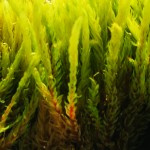 |
 |
 |
 |
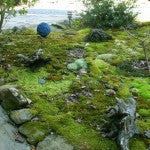 |
 |
 |
Seasons & Transitions

As seasons change, mosses will remain a constant expanse of green... at least from a distance... and even in the winter. If you take the time to observe mosses in their transitional stages, which occur throughout all months and vary by bryophyte colony, you will be delighted with brilliant colors of sporophytes – a good sign that your mosses are happy campers. The subtle changes of green can range from bright chartreuse to deep juniper. Upon occasion, the leaves of some mosses turn intense yellow (Hypnum and Thuidium). This golden color transition is not indicative of a final life cycle such as in the case of fall leaf color on trees.
With all these glowing endorsements, be prepared that some mosses go through "ugly" transitions or periods of adjustment. If you practice patience and nurture these transitioning colonies, they will astound you once again with their "green."
Note: Some bryophytes have leaves that are not normally green. Sphagnum magellanicum, a moss, is a deep pink/rose color naturally; and Frullania asagrayana, a liverwort, creates red trails on tree bark.
Walking
 After watering mosses, always walk on your mosses. This walking process helps to set the rhizoids establishing their foothold on the ground. Resilient moss plants do not have stiff stems and don't usually break. If fragmentation does occur, the pieces could be the beginning of new plants which is advantageous.
After watering mosses, always walk on your mosses. This walking process helps to set the rhizoids establishing their foothold on the ground. Resilient moss plants do not have stiff stems and don't usually break. If fragmentation does occur, the pieces could be the beginning of new plants which is advantageous.
Quick Tips
- Assess your micro-climates and choose appropriate moss types for your design concept, purpose and substrate.
- Clear soil of debris and adjust pH as needed prior to planting.
- Place mosses directly on hard-packed soil (or use elaborate substrates for water retention and/or weed prevention, if needed).
- Interleaf “carpet” mosses and place mounds close together to achieve an instant patchwork of continuous green as well as to help hold moisture.
- Mosses that grow in horizontal modes or mats tend to grow faster than mound types. Using hand-sized pieces, growth can be observed in a matter of months and an expansive carpet can be achieved within a couple of years. Fragments of moss plants can be used as filler between patches.
- Keep leaf litter to a minimum. It is not a daily task but leaves should not remain for months at a time. Please note: A certain amount of debris for brief periods can provide valuable nutrients and moisture.
- Weed mosses as needed. Unwanted plants can be removed easily from moss colonies if caught early.
- Water your mosses consistently but don't let them stay soggy. Some mosses need to dry out and won't tolerate "wet feet." Research indicates a direct correlation between optimal moisture and reproductive growth.
- Walk on your mosses. Sit on soft cushion mounds. Take a nap on your lofty, moss carpet.

Celebrate life in your moss garden.

Enjoy your marvelous mosses with all your senses.

